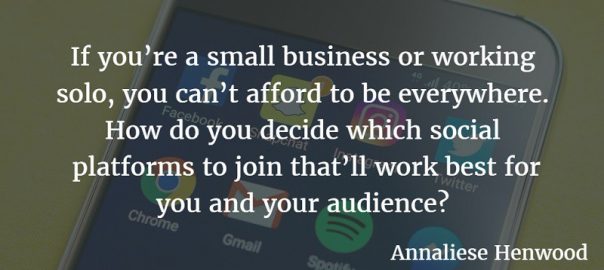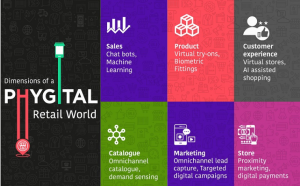Whenever we turn around, there’s either a new big feature or new social platform available with full business opportunity. We used to have the typical Facebook and Twitter platforms, but now there’s Instagram, Pinterest, Snapchat, LinkedIn…
If you’re a small business or working solo, you can’t afford to be everywhere. How do you decide which platforms to join that’ll work best for you and your audience?

You have seven factors to evaluate per platform. To make it easier for you, you can consider platforms as a whole, using these factors. This would be more efficient than going through every platform individually and help you target your business needs more precisely.
— — —
1) Audience
First and foremost, you need to research your target audience. You’ll want to find them first because they are who will bring you business. Where are they most active? Or, more importantly, where are they actively seeking you out? Do they mention you on a consistent basis on Twitter? Even if they’re really active on Instagram, do they want to see you there?
People can be quite widespread on social media as a whole. There are so many platforms to choose from. The best way to evaluate audience involvement is to examine the demographics of each platform. HubSpot does a great job at making this easy with their 2017 benchmark infographic.
These are just a few of the highlights:
- Facebook is the best place to reach Millennials and Generation X (ages 18-49)
- YouTube reaches more 18-49 year olds than any cable network in the USA
- 53% of Instagram users follow brands
- People who follow a product link via Pinterest are 10% more likely to make a purchase than users of other social networks
You can find other key platform statistics on HubSpot’s website.
Regardless of your business or personal preferences, you need to remember that your social media marketing won’t be effective if you aren’t paying attention to your audience’s own preferences. They have the final say as to which platforms you should be on. At this point, you should have a list, so now it’s time to narrow that down. If it’s a short list, it’s time to see which platforms should have the highest investment.
2) Content type
Yes, there are many social networks out there these days. Do you feel overwhelmed by that list? That’s nothing if you consider how many unique content features each platform has. It can be quite daunting, so how do you determine which platform is right based on these content types?
Similar to the audience analysis from before, you don’t want to focus on your own preferences here. The content you choose should be what your target audience wants to see from you. Even if you prefer the written word, video is a huge, dominating part of social engagement now. You’ll need to adapt if you want to see your social efforts bring results.
Which content types are most popular these days?
- Video in the form of prerecorded or live streaming
- Image sharing
- GIFs and emojis
If you’re not ready to create the above content, you need to get moving on that. Your audience isn’t going to wait for you to do this either. They’ll go straight to your competitors if you take too long.
When you’re ready to create a content type that appeals to your target audience, it’s time to find out which platforms lead the way with that format.
Which platforms are emphasizing these content types?
- Snapchat, Instagram, and Facebook all offer live-streaming services in one form or another. Social Media Examiner has an article to help you decide which platform is best for live video.
- YouTube is the ultimate place to host your recorded videos. Moz has a rather thorough article emphasizing YouTube’s marketing value. It’s an older article, but it still has a lot of great advice.
- Instagram and Pinterest are the leaders in image sharing. Even if you’re not a designer, you can create images that appeal to your audience. Buffer published an article on creating engaging images that focuses on non-designers.
- Twitter users love GIFs and emojis. Hootsuite offers two definitive articles on these features. Their GIFs guide gives you clear instructions on where to find them and how to make them yourself. Their emoji guide helps you understand best practices for when and how to use them.
This is another way you can determine which social media platform your business should be on, but there are still five other key elements you must evaluate.
3) Frequency
Yes, you want to be where your audience is seeking you out, but you need to be ready for what that entails. Some social networks require a heavy time commitment.
Let’s examine a few of the most common frequencies:
Twitter requires posting content at least five times a day. This doesn’t include the real-time engagement and interactions you should offer. Twitter is a fast-paced platform, and if you’re not tweeting a lot, you won’t reach your target audience enough.
Pinterest content has a really long shelf-life, so it’s not a place where you need to create a lot of pins every day (although you still can). Some say you can pin up to five times a day, but a minimum of one a day can still drive traffic because of its evergreen nature.
Instagram has a great engagement rate on content as a whole. People love engaging with brand content when it’s suited to their interests. You don’t want to overwhelm their feed though, so one or two posts a day is best.
LinkedIn is a professional network, so it’s relatively dormant over the weekends. You won’t see as much activity on your content if you post over the weekend, so focus on the weekdays. You also don’t want to post a lot on this platform. Once a day is enough.
Facebook posting is tricky because of the organic reach dilemma. You don’t want to publish a lot to try to beat the algorithm. That’ll upset your audience and increase negative reactions. Instead, post twice a day but with content your audience will engage with. This will improve your reach.
Is there such a thing as posting too much?
As I’ve hinted toward, there is such a thing as posting too much on social media, and this includes Twitter. Impact Branding & Design goes into this posting frequency issue in an article on their blog. You need to experiment and strategize your frequency to determine how much is enough and how much is too much. It helps to bring conversations to private messaging systems when appropriate.
Consistency is key.
Another important point to make is that you need to be consistent. Your audience will start to depend on your schedule. If you’re unreliable, your content will get lost or missed because your audience won’t be looking for it then.
In the end, when you evaluate posting frequency, you need to do some thinking about whether you have the resources to maintain such a schedule. We’ll discuss your business capabilities a bit later.
4) Engagement
Social media isn’t just about scheduling posts to go out at certain times and that’s it. Automating your social media is a necessary evil, but you can’t depend on it 100%. You need to be ready to engage with your audience, and this should be your largest time investment. It’s more important than your automated content.
Engaging with your target audience 1-to-1 is how you’ll build trust and relationships. The more people start to trust you, the more likely they’ll buy from you. Impact Branding & Design explains this important element of social media marketing in their article on two-way conversations. You want your business brand to connect with people with a human feel. You don’t want to be a blank wall or robot account that doesn’t engage with people directly. People expect personable conversation from you.
What’s the best way to engage?
When you’re trying to analyze how to engage with your target audience, it’s best to start by looking at your existing data. Kissmetrics gives you four social media report ideas and their best tools to help you discover what is working for your audience in terms of engagement. It’s very important that you depend heavily on the data available to you because it’s unbiased and accurate. Your own opinions aren’t as effective.
When you’re looking at the different social platforms, it’s important that you evaluate how you might offer engagement with your brand. Will you participate in Twitter chats to give your brand personality and influence? Will you offer real-time customer service for customers and prospects? These are things you need to think about when considering which platforms to join.
5) Business relevance
If you’re a business-to-business company, you might think this limits which platforms you should join. That’s not necessarily true. Yes, LinkedIn is probably your best platform for direct leads and sales, but it’s not the only place where you’d see benefits. Sometimes the most unlikely option can become your best source for business. It’s all about how you approach the platform and its audience.
Your business may be selling parts for power plants or something equally mundane, and I’m sure that makes maintaining an interesting blog challenging. However, on social media, you can still draw attention to your business.
Let’s examine how to maintain business relevance while still appealing to the right audience:
Back to the power plant salesman. When you’re using social media, don’t focus on the blunt sale. That’s not how social media works. You can still be relevant to your business without being too sales-oriented.
You can share blog content, using text or video to draw attention from other individuals. You shouldn’t be targeting other brands but rather the individuals in charge of them. The person who buys parts for the power plant they work for is the person you should engage with on a regular basis.
You can offer customer service to the customers who have already purchased from you. This will help you build brand advocates who can spread the word about their positive experience with you. Word of mouth is your most powerful tool because prospects trust customers more than they trust you.
You don’t want to go way off topic when you join a new platform, such as sharing content that has nothing to do with your industry. You may want to join trending discussions, but you want to make sure you’re staying focused. Consider how you’ll stay business-focused while maintaining value for your audience when evaluating a social media platform.
6) Business capabilities
Yes, you want to be where your target audience is looking for you. Yes, you want to offer high-value and plenty of engagement. However, when you’re a one-person team or small business, you need to consider what’s practical for you. You can’t be everywhere, right? That’s why you need to consider your own capabilities and limitations.
Sometimes, you can’t appeal to your target audience 100%. When you have a lot on your plate already, you need to narrow down your list of social media platforms to just the ones that’ll bring the biggest return for the lowest investment. With each platform you choose, you need to be ready to fully immerse yourself in all its features and best practices. You don’t want to create a static ghost account that has no activity or value. Choose only the platforms in which you can build a presence effectively.
7) Business goals
The last element to evaluate when considering which social media platforms to join is key. You must have goals for what you want to accomplish with your social media marketing. It should be part of the social media strategy you’ve built. These goals should help you with this platform challenge because they are the outcome you seek.
If you’re looking for sales out of social media, be ready for extensive patience.
You want to be on a platform where you can engage in a way that builds trust and appeal. Your target audience will be looking for your offerings on certain platforms, perhaps even mentioning their needs in a post. You can follow these mentions using a tool or simply searching for the keyword through platform search. When you see that someone is looking for something you offer, this is your opportunity to get that sale.
If you’re looking for subscribers for your blog, make sure you’re on platforms that are link-friendly to drive traffic to your website.
Instagram might not be best for you in this case because you only get one link on your profile and none in organic posts. On other platforms, you can use catchy headlines and a link preview to draw in interested readers. Make sure you’ve optimized your content to get readers seeking more from you. Include a call-to-action and even content upgrades to get them to subscribe. Social media is a great starting point for this process.
Whatever goal you have for your social media marketing, it is one of the most important considerations you have. You don’t want to waste resources on the wrong platforms. You want to be on platforms where your goal can be achieved.
— — —
That’s it for the seven elements. It’s now time for you to make that final decision as to which platform or platforms you’ll join. Will it be Twitter? Instagram? Facebook? Snapchat? Any others?
I have a definitive guide to five of the leading social media platforms, including: Facebook, Twitter, LinkedIn, Instagram, and Pinterest. You can access the free download by clicking here.
Digital & Social Articles on Business 2 Community(40)








